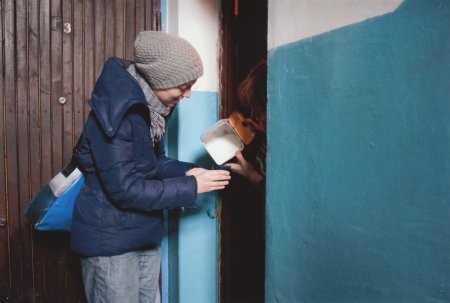Young Polish Artists on Tour - Berlin | Looking into Neighbourship
12 Nov - 10 Dec 2011
YOUNG POLISH ARTISTS ON TOUR - BERLIN | LOOKING INTO NEIGHBOURSHIP
Artists Karolina Breguła, Monika Drożyńska, Karolina Freino, Alicja Karska / Aleksandra Went
12 November – 10 December, 2011
Looking into Neighbourship presents works by Karolina Breguła, Monika Drożyńska, Karolina Freino and Alicja Karska/Aleksandra Went, that explore the changes in urban space and of the various forms of neighbourship. The artists have turned their inquisitive gaze on "small things", which allow the bigger questions, such as the treatment of history and its evidence, the relationship between the public and the private or the challenges created by cultural differences, to shine through.
For her project Good Neighbours (2007-2009) Karolina Breguła traveled to Poland’s seven neighbour countries, where she carried out activities usually associated with neighbours living in the same block of flats, – such as watering the flowers, borrowing food ingredients on the door, or listening on the wall. The prosaicness of the activities virtually skips the entire burden of historical intertwinement, which actually separates the neighbouring countries. The artist shows with humour that overcoming cultural differences is possible if one begins with the common items of everyday life.
Monika Drożyńska photographed graffiti during summer, which she embroidered in winter time on table napkins, together with some decorative ornaments. In her project Urban Embroidery (2010) the graffiti texts were given back to urban space. For one month each, the artist showed photographs of the embroideries on LED video boards, using graffiti texts such as “Stop complaining!” or “Winter piss off!” The embroideries – generally associated with the private sphere – thereby attain the assumed visibility of mass media messages.
Karolina Freino documented in her project Walls and Sandpits (2007) 40 locations at which parts of German and Jewish headstones had been used to construct walls, sandpits, garbage storage sheds and pedestrian paths. Based on the results of her research, Szczecin’s four largest dailies published obituaries containing fragments of texts, which had still been decipherable on the stones, and their translations into Polish. The obituaries were accompanied by a photograph of the headstone and a description of its place of finding. The remarkably numerous reactions on the project seem to prove that a dialogue between the town and its past was long overdue.
The question of how historic monuments are dealt with is also important to Alicja Karska and Aleksandra Went. Since 2007 they have been photographing entrances to towns for their project Polish Cities. During the socialist era, these town entrances had been appointed with elaborate welcome-sculptures (pol. witacze), visualizing the name of the town. The artists document the great variety and “beauty” of these objects, as well as their decay, and address the issue of the inhabitants' alienation from local remnants of history, a process going on all over the world.
The exhibition is organised in collaboration with Łaźnia, Gdańsk, and on show in cooperation with Kronenboden in both project spaces in Schwedenstraße 16. A catalog has been published.
Artists Karolina Breguła, Monika Drożyńska, Karolina Freino, Alicja Karska / Aleksandra Went
12 November – 10 December, 2011
Looking into Neighbourship presents works by Karolina Breguła, Monika Drożyńska, Karolina Freino and Alicja Karska/Aleksandra Went, that explore the changes in urban space and of the various forms of neighbourship. The artists have turned their inquisitive gaze on "small things", which allow the bigger questions, such as the treatment of history and its evidence, the relationship between the public and the private or the challenges created by cultural differences, to shine through.
For her project Good Neighbours (2007-2009) Karolina Breguła traveled to Poland’s seven neighbour countries, where she carried out activities usually associated with neighbours living in the same block of flats, – such as watering the flowers, borrowing food ingredients on the door, or listening on the wall. The prosaicness of the activities virtually skips the entire burden of historical intertwinement, which actually separates the neighbouring countries. The artist shows with humour that overcoming cultural differences is possible if one begins with the common items of everyday life.
Monika Drożyńska photographed graffiti during summer, which she embroidered in winter time on table napkins, together with some decorative ornaments. In her project Urban Embroidery (2010) the graffiti texts were given back to urban space. For one month each, the artist showed photographs of the embroideries on LED video boards, using graffiti texts such as “Stop complaining!” or “Winter piss off!” The embroideries – generally associated with the private sphere – thereby attain the assumed visibility of mass media messages.
Karolina Freino documented in her project Walls and Sandpits (2007) 40 locations at which parts of German and Jewish headstones had been used to construct walls, sandpits, garbage storage sheds and pedestrian paths. Based on the results of her research, Szczecin’s four largest dailies published obituaries containing fragments of texts, which had still been decipherable on the stones, and their translations into Polish. The obituaries were accompanied by a photograph of the headstone and a description of its place of finding. The remarkably numerous reactions on the project seem to prove that a dialogue between the town and its past was long overdue.
The question of how historic monuments are dealt with is also important to Alicja Karska and Aleksandra Went. Since 2007 they have been photographing entrances to towns for their project Polish Cities. During the socialist era, these town entrances had been appointed with elaborate welcome-sculptures (pol. witacze), visualizing the name of the town. The artists document the great variety and “beauty” of these objects, as well as their decay, and address the issue of the inhabitants' alienation from local remnants of history, a process going on all over the world.
The exhibition is organised in collaboration with Łaźnia, Gdańsk, and on show in cooperation with Kronenboden in both project spaces in Schwedenstraße 16. A catalog has been published.

